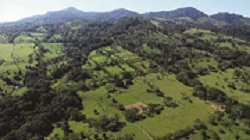Green growth, landscape restoration and climate-change mitigation go hand-in-hand, says Dieterle
22 December 2017

The landscape in the Sierra de Los Tuxtlas mountain range in Mexico, which was once almost fully forested. Green growth is essential for restoring forest landscapes, combating climate change, and bringing other benefits. Photo: G. Sánchez-Vigil
Speaking at the Global Landscapes Forum in Bonn, Germany, earlier this week, Dr Dieterle said that green economic growth is needed to drive forest landscape restoration, which, in turn, would help conserve biodiversity while generating employment, storing carbon and ensuring a sustainable supply of timber. Sustainably produced timber would provide climate-change mitigation benefits in addition to carbon storage because it can be used to substitute for fossil products. “Such substitution benefits could eventually exceed those of all other forest-related measures combined,” he said.
New studies indicate that demand for timber and forest products is increasing globally as the population grows, said Dr Dieterle. In many cases, demand is exceeding supply, leading to two potential scenarios: further forest deforestation and landscape degradation, or, more positively, an increase in productive forests that would help drive the green economy and mitigate climate change.
“We need to look at forest products the same way we look at food: there is no alternative other than producing and using them,” said Dr Dieterle. If rapidly increasing demand for forest products is not met sustainably, there will be more deforestation and landscape degradation or substitution with non-renewable alternatives, both of which “have the potential to strongly undermine current efforts to fight climate change and promote sustainable development”.
Dr Dieterle said that forested landscapes are essential for fulfilling the basic needs of growing populations and are also extremely important for the provision of goods and services of local, national and global importance. Forest landscapes, therefore, are crucial for development, green growth and climate-change mitigation and adaptation, and their restoration and productive use would yield “triple wins”.
Reducing demand for forest products through protection is not the answer, according to Dr Dieterle. In his view, landscape restoration efforts should focus on creating economically viable, productive forests that can contribute to the green economy. He proposed five steps in his approach:
- Protect essential high-biodiversity forests for the national and global public good.
- Restore degraded multipurpose forest landscapes for productive uses and economically viable benefits.
- Invest in highly productive forests for mass products (timber, pulp, energy, etc.).
- Manage and use existing forests sustainably and more efficiently.
- Promote green, deforestation-free supply chains and trade in domestic and international markets.
Dr Dieterle said that ITTO stands ready to help harness the role of productive tropical forests and landscape restoration.